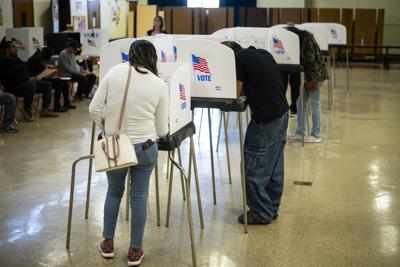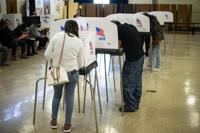
Voting booths and voters are seen at a polling location at Beltsville Academy on Election Day, on Nov. 5, 2024, in Beltsville, Md. Credit: Graeme Sloan for The Washington Post via Getty Images
The Voting Rights Act (VRA) of 1965, enacted during the height of the civil rights movement, stands as a testament to Americans’ rights to democratic participation. Yet, nearly 60 years after its passage, this landmark legislation faces unprecedented challenges that threaten to undermine its fundamental protections.
The Supreme Court is hearing cases that could weaken provisions of the VRA, including Louisiana v. Callais, a redistricting dispute that challenges Section 2 of the law prohibiting voting practices that discriminate against racial or language minority groups. The 8th Circuit Court of Appeals has weakened the ability of private citizens to file lawsuits under the VRA, and the Supreme Court will potentially decide if that restriction will remain in place. Meanwhile, Congress is considering the Safeguard American Voter Eligibility Act (SAVE) Act, which would require people to show proof of citizenship when registering to vote. However, critics say the requirement could prevent certain eligible voters from voting in elections.
“There have been countless changes to voting at the local level as well,” Sean Morales-Doyle, director of the Voting Rights and Elections Program at Brennan Center For Justice, said in an email. “And our recent research demonstrates that the net result is a growing gap in participation between white and non-white voters.”
A new dawn for voting rights
The VRA emerged from one of the most tumultuous periods in U.S. history. On March 7, 1965, peaceful protesters marching for voting rights were brutally attacked by state troopers on the Edmund Pettus Bridge in Selma, Alabama. This violent confrontation, known as “Bloody Sunday,” galvanized national support for federal voting protections. Five months later, President Lyndon B. Johnson signed the Voting Rights Act into law, with Dr. Martin Luther King Jr. and other civil rights leaders present at the historic signing.
The VRA codified and enforced the voting rights guaranteed by the 14th and 15th Amendments by outlawing discriminatory voting practices used by state and local governments, particularly in the South.
The legislation’s impact was immediate and profound. In some counties, fewer than 10% of eligible Black voters were registered, most often because of discriminatory tests or arbitrary denials. By the end of 1965, about 250,000 new Black voters were registered. Two years later, nearly 60% of eligible Black voters in Mississippi, for example, were registered to vote.
“The VRA has historically stood as one of the clearest legal assurances that the promise of democracy would be equitably extended to every American,” Christopher Migliaccio, attorney and founder of Warren & Migliaccio, L.L.P., explained in a written response. Migliaccio has represented various clients in voting access and election compliance work in Texas, including under the state election code and in the context of local elections where questions regarding polling access and districting often received national attention. “However, sixty years later, it is eroding from its foundation.”
Eliminating preclearance
A key turning point in this erosion was the 2013 Supreme Court case Shelby County v. Holder. The case drastically changed U.S. voting rights by striking down the VRA’s “preclearance” rule, which had required states with histories of racial discrimination to get federal approval before changing voting laws.
“Since [the Supreme Court] ended pre-clearance in 2013 … State Legislatures have increasingly passed more restrictive laws under the guise of protecting voting rights by preventing Fraud,” Samantha Pettey, a history and political science professor at the Massachusetts College of Liberal Arts, said in a written response.
Morales-Doyle told Prism that the “racial turnout gap is growing across the country, but it has been growing twice as fast in previously covered jurisdictions since the Shelby County decision, proving that the decision contributed to a skew in whose voices are heard in our democracy.”
Texas Republicans are pursuing a mid-decade redistricting effort that aims to flip five Democratic congressional seats to Republican control. This comes after a court ruling that found some of the state’s current districts were illegally drawn to racial gerrymandering. If the new map is approved, Texas’ congressional delegation would shift from 25 Republicans and 13 Democrats to 30 Republicans and eight Democrats. The plan is now being reviewed by a federal court. The redistricting push comes despite the 2024 presidential election showing a closer political split in Texas, with 56.2% of voters supporting the Republican candidate and 42.5% backing the Democrat.
Similar scenarios are playing out in other states as well. Michael Kruse, a criminal defense lawyer and head of Kruse Law Firm, emphasized the gravity of these changes affecting the VRA. “The most worrying aspect of its present unraveling is the way it is revealing the weakness of legal safeguards that used to be deemed inviolable,” Kruse said in a written interview. “By invalidating preclearance, the Supreme Court killed the one most effective deterrent to discriminatory laws.”
Kruse added, “As a criminal attorney, I witness every day how the law would be eroded not through some caricature breakdown but rather through minor, calculated disarmaments of protections that formerly provided some protection to groups at risk.”
Far-reaching implications
The challenges extend beyond racial discrimination. “Voters with disabilities face barriers every day when voting and accessing public life,” Shira Wakschlag, senior executive officer of legal advocacy and general counsel at The Arc of the United States, said in an email statement. The nonprofit organization advocates for the rights and full inclusion of people with intellectual and developmental disabilities. “They are twice as likely to encounter difficulties when voting in person and by mail and significantly more likely to require assistance when voting.”
Additionally, current legal battles could further weaken the VRA’s remaining protections. Particularly concerning is Louisiana v. Callais, the Supreme Court case deciding whether Louisiana went too far in using race to draw a new voting map that added a second majority-Black district to fix past discrimination.
“This case could cause irreparable harm to Black Louisianans both in the immediate and long term,” said Alanah Odoms, the executive director of the American Civil Liberties Union of Louisiana, in an email statement. The Supreme Court may potentially strip away what’s remaining of the VRA, allowing Louisiana and other states to draw districts that completely disenfranchise Black communities, Odoms said, adding that about a third of Louisiana is Black. The VRA also includes language assistance provisions. “These matter to immigrant communities where someone has become a citizen, but English is not their first language,” Attiba Ellis, a law professor at Case Western Reserve University who has previously spoken publicly about the VRA, said in an interview. “They nonetheless will have their right to vote be protected.”










(0) comments
Welcome to the discussion.
Log In
Keep it Clean. Please avoid obscene, vulgar, lewd, racist or sexually-oriented language.
PLEASE TURN OFF YOUR CAPS LOCK.
Don't Threaten. Threats of harming another person will not be tolerated.
Be Truthful. Don't knowingly lie about anyone or anything.
Be Nice. No racism, sexism or any sort of -ism that is degrading to another person.
Be Proactive. Use the 'Report' link on each comment to let us know of abusive posts.
Share with Us. We'd love to hear eyewitness accounts, the history behind an article.